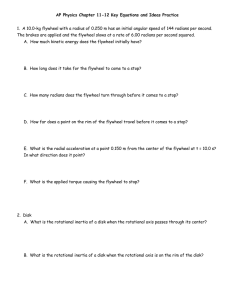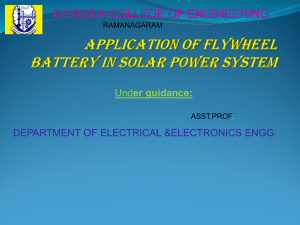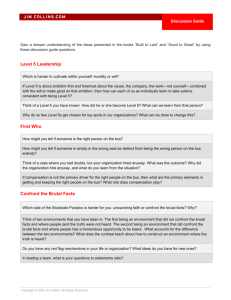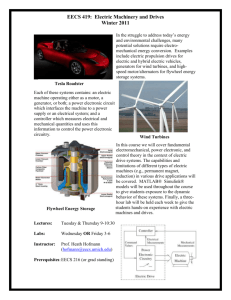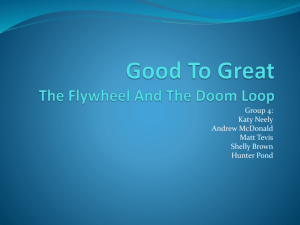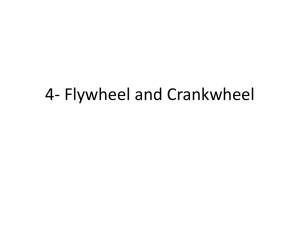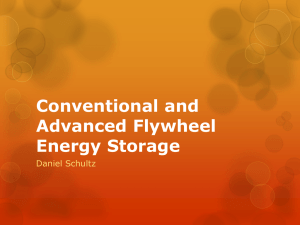1999-01-1159
advertisement
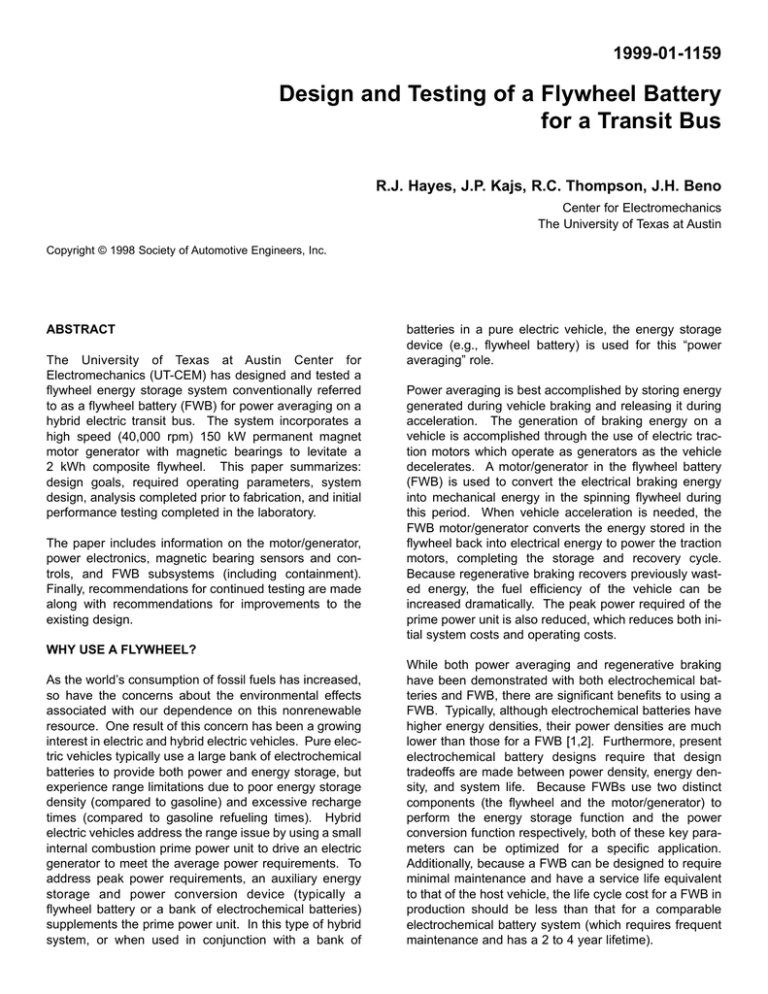
1999-01-1159 Design and Testing of a Flywheel Battery for a Transit Bus R.J. Hayes, J.P. Kajs, R.C. Thompson, J.H. Beno Center for Electromechanics The University of Texas at Austin Copyright © 1998 Society of Automotive Engineers, Inc. ABSTRACT The University of Texas at Austin Center for Electromechanics (UT-CEM) has designed and tested a flywheel energy storage system conventionally referred to as a flywheel battery (FWB) for power averaging on a hybrid electric transit bus. The system incorporates a high speed (40,000 rpm) 150 kW permanent magnet motor generator with magnetic bearings to levitate a 2 kWh composite flywheel. This paper summarizes: design goals, required operating parameters, system design, analysis completed prior to fabrication, and initial performance testing completed in the laboratory. The paper includes information on the motor/generator, power electronics, magnetic bearing sensors and controls, and FWB subsystems (including containment). Finally, recommendations for continued testing are made along with recommendations for improvements to the existing design. batteries in a pure electric vehicle, the energy storage device (e.g., flywheel battery) is used for this “power averaging” role. Power averaging is best accomplished by storing energy generated during vehicle braking and releasing it during acceleration. The generation of braking energy on a vehicle is accomplished through the use of electric traction motors which operate as generators as the vehicle decelerates. A motor/generator in the flywheel battery (FWB) is used to convert the electrical braking energy into mechanical energy in the spinning flywheel during this period. When vehicle acceleration is needed, the FWB motor/generator converts the energy stored in the flywheel back into electrical energy to power the traction motors, completing the storage and recovery cycle. Because regenerative braking recovers previously wasted energy, the fuel efficiency of the vehicle can be increased dramatically. The peak power required of the prime power unit is also reduced, which reduces both initial system costs and operating costs. WHY USE A FLYWHEEL? As the world’s consumption of fossil fuels has increased, so have the concerns about the environmental effects associated with our dependence on this nonrenewable resource. One result of this concern has been a growing interest in electric and hybrid electric vehicles. Pure electric vehicles typically use a large bank of electrochemical batteries to provide both power and energy storage, but experience range limitations due to poor energy storage density (compared to gasoline) and excessive recharge times (compared to gasoline refueling times). Hybrid electric vehicles address the range issue by using a small internal combustion prime power unit to drive an electric generator to meet the average power requirements. To address peak power requirements, an auxiliary energy storage and power conversion device (typically a flywheel battery or a bank of electrochemical batteries) supplements the prime power unit. In this type of hybrid system, or when used in conjunction with a bank of While both power averaging and regenerative braking have been demonstrated with both electrochemical batteries and FWB, there are significant benefits to using a FWB. Typically, although electrochemical batteries have higher energy densities, their power densities are much lower than those for a FWB [1,2]. Furthermore, present electrochemical battery designs require that design tradeoffs are made between power density, energy density, and system life. Because FWBs use two distinct components (the flywheel and the motor/generator) to perform the energy storage function and the power conversion function respectively, both of these key parameters can be optimized for a specific application. Additionally, because a FWB can be designed to require minimal maintenance and have a service life equivalent to that of the host vehicle, the life cycle cost for a FWB in production should be less than that for a comparable electrochemical battery system (which requires frequent maintenance and has a 2 to 4 year lifetime). FLYWHEEL BATTERY REQUIREMENTS FOR A TRANSIT BUS APPLICATION The University of Texas at Austin Center for Electromechanics (UT-CEM) and its industrial partners, AlliedSignal Aerospace and Avcon Controls Inc., have developed a FWB for power averaging on a 12,725 kg (28,000 lb) hybrid electric transit bus. In this system the primary benefits of the FWB are to reduce the size of the prime power unit (while still meeting the required performance), reduce fuel consumption, and consequently reduce emissions. Auxiliary Loads Engine Model DC Generator Electric Converter Motor/ Generator Vehicle Dynamics DC-AC Inverter Motor/ Generator Flywheel At the initiation of the project, UT-CEM developed a computer model of the transit bus to determine the appropriate size of FWB in terms of power and energy, and to determine the effects of adding a FWB to a hybrid electric drive train. This model originated as a fairly simple FORTRAN model which only accounted for the weight and desired performance of the bus and output the required flywheel size when used in parallel with the prime mover. The model highlighted some simple "rules of thumb" for flywheel battery sizing for a hybrid electric vehicle. The first is that the prime power size must be capable of meeting all of the power needs (drive train and auxiliaries load) at the highest anticipated cruising speed (highest average power requirement). The second rule of thumb is that the FWB power level should be approximately equivalent to the peak regenerative braking power of the traction motor(s). This is typically equal to the rated wheel motor size. (While wheel motors can produce more than their rated load in short braking situations, practical considerations make it inconvenient to access this excess capacity frequently.) The third rule is that the available energy in the FWB should be roughly equal to the kinetic energy of the vehicle at cruise speed which, neglecting losses, is also the energy required to accelerate the vehicle. Following development of the initial model, UT-CEM built a more sophisticated model to include different driving cycles and loads and more realistic component models. The improved model was based in part on the Idaho National Energy Laboratory simulation program, SIMPLEV. The model developed at UT-CEM simulates a series hybrid electric drive train with a flywheel as intermediate energy storage. A block diagram of the system modeled is shown in Fig. 1. The UT-CEM simulation used a steady state efficiency versus torque and speed map for most of the electromechanical and electrical conversions. To improve the accuracy of the UT-CEM simulation, many of the SIMPLEV efficiency maps were adapted for use with the UT-CEM simulation. Models for the components of the UT-CEM system were based on the models described in SIMPLEV. In order to achieve optimal fuel economy, it is necessary to have an energy management controller which 8301.0192 Fig. 1. Hybrid electric drive train model regulates power flow from either the engine or the flywheel throughout the drive cycle. According to published information from functioning systems such as the Magnet Motors system [1], fuel savings when using the flywheel properly over real routes can be approximately 30%. A portion of these gains are a result of using a smaller engine optimized for a specific speed and power range. Because UT-CEM used the same engine model for the simulations both with and without the flywheel (as opposed to using a smaller engine for the flywheel based system), the simulated fuel savings using the unoptimized engine model were approximately 15%. Table 1 shows the specifications of the components used in simulation. This simulation confirmed that the UT-CEM Table 1. Component specifications used in the UT-CEM simulation System weight Frontal area Drag coefficient Route Grade Auxiliary power requirement Flywheel energy 11,365 kg (25,000 lb) 6 m2 0.65 LA supplied Line 16 Flat 5 kW Flywheel power Prime generator 1 kWh Delivered 140 kW 180 kW Peak drive power 162 kW Wheel motor rating 0 to 90 kph (0 to 55 mph) 150 kW 60 s (108 kW required for 55 mph cruising) (power under full acceleration) (72 s specified for typical transit bus) flywheel battery with a peak power rating of 150 kW (110 kW continuous) and delivered energy of 1 kWh was more than adequate for the simulated system. It also indicated that using the flywheel to aid acceleration could reduce the required prime generator size by approximately 70 to 80 kW. The 180 kW prime generator size is the generator presently planned for the Houston Metropolitan Transit Authority advanced technology transit bus that will serve as the UT-CEM FWB demonstration platform. The FWB system could enable a reduction in the engine and generator size to reduce fuel consumption. Beyond the basic power and energy requirements, the transit bus imposes additional environmental conditions that impact flywheel design. These include an input and output voltage of 360 Vdc ±10% and an ambient temperature range in the engine compartment of -40˚ to 63˚C (-40˚ to 145˚F). The desired component life of the bus of 15 years, in combination with the anticipated FWB duty cycles, created additional issues that are discussed in later sections. Non-integrated Topology • larger than other topologies, but may have most simple assembly • maximum use of conventional MG systems and technology • flexible/adaptive design • power generation outside of vacuum • requires shaft seal or coupling FLYWHEEL DESIGN CONSIDERATIONS With the aforementioned requirements in mind, the UTCEM team designed a high performance, low mass FWB for the transit bus. Maximizing energy density in a flywheel implies a high rotational speed and a high strength material with low density. This leads to carbon fiber composites as the material of choice for modern high performance flywheels [3]. These materials are capable of operating safely at surface speeds (on the outer diameter) of approximately 1,000 m/s which, for a 0.44 m (17.2 in.) diameter flywheel, results in rotational speeds of approximately 40,000 rpm. The high surface speeds result in unacceptable windage losses unless the flywheel operates in a vacuum. This means that heat removal from the FWB rotor must be accomplished via radiation, which severely limits rotor cooling. Consequently heat generation on the FWB rotor becomes a major "design driver" and UT-CEM chose low loss, non-contacting magnetic bearings and a permanent magnet motor generator to reduce rotor heating. For both of these components, most heat generation is in the stator windings, which can be located outside the vacuum and actively cooled. In parallel with the evaluation and selection of critical components, a number of system level decisions were made. These had to do primarily with the level of integration in the system. There are good arguments for highly integrated systems (in which the flywheel and motor/generator rotor are one component) and for nonintegrated systems (in which the flywheel and motor/generator are in separate housings). A partially integrated system was selected, in which the flywheel and motor generator are separate components but ride on the same shaft and in a single housing (Fig. 2). This Partially Integrated Topology • smaller and more efficient than non-integrated • good use of available motor/generator technology, but integration required • design adaptability good • good for medium and low average power • heat generation on rotor requires careful engineering Fully Integrated Topology (Inside-Out) • most compact system • special purpose flywheel system • good for medium and low average power • favors use of permanent magnet machine • heat generation on rotor requires special engineering 8301.0193 Fig. 2. Flywheel battery integration options system allowed the team to integrate an existing, proven motor/generator concept with a safe robust flywheel rotor design. Additional system requirements had to do with the safe operation of the FWB in a mobile application. This complex issue has been discussed in detail in previous papers [4,5,6]. FWB safety research is continuing under programs jointly funded by the Defense Advanced Research Projects Agency (DARPA) and industry. (Some initial results from the flywheel safety program are already available on the internet at the site for the Southern Coalition for Advanced Transportation, www.advtrans.org.) UT-CEM FWB DESIGN OVERVIEW To meet the aforementioned design requirements, UTCEM and its industrial partners developed a standalone FWB system (Fig. 3) complete with power electronics. The flywheel design stores 2 kWh of energy at 40,000 rpm, and produces 110 kW of continuous power (150 kW peak). UT-CEM provided the advanced composite rotor technology while other members of the team, Avcon Controls Inc. and AlliedSignal Aerospace Company, provided complementing magnetic bearing and motor/generator components, respectively. A brief explanation of each of the critical components follows. COMPOSITE FLYWHEEL ROTOR opposed to a burst) in the event of an overspeed condition, the radial preload between the two outermost rings is designed to go into tension before the hoop stress in the rings reaches its ultimate strength. The material and processing system used in fabrication of the rings is proprietary to UT-CEM and incorporates features developed over fifteen years of high performance rotor development for the Department of Defense to arrest radial crack development and limit stress relaxation in the assembly. MOTOR/GENERATOR A two pole permanent magnet motor/generator rotor designed by AlliedSignal Aerospace incorporates a number of unique features to allow it to operate at high rotational speeds with minimal heat generation on the rotor. In particular, an inconel sleeve shrunk onto the rotor contains the magnet radially and also provides the structural connection to the two stub shafts. A beryllium copper sleeve on the outside of the inconel sleeve reduces eddy current losses on the rotor. The stator design incorporates a three phase, two pole, toothless design which results in minimal end turn length and reduced harmonics. Flow-through liquid cooling of the windings is enhanced by using small gauge litz wire that has not been potted. Peak power, which is limited by the power electronics, is 150 kW, with a 110 kW continuous power rating. POWER ELECTRONICS The UT-CEM designed composite flywheel rotor (Fig. 4) utilizes a series of concentric cylindrical rings press-fit together to provide a significant radial preload. This assures that the composite sections remain in contact with each other and with the titanium hub, which is integral with the rotor shaft. To facilitate a benign failure (as The motor/generator is driven by an AlliedSignal Aerospace designed three phase inverter operating from a nominal bus voltage of 360 Vdc (±10%) and controlled by a logic control unit (LCU) that will respond to a request for power (±) from the vehicle control system. The three Backup bearings Radial bearing Stator winding Permanent magnet rotor Composite flywheel Containment ring (concept) Combo bearing S 8301.0079b 8301.0129.1 Fig. 3. UT-CEM flywheel battery designed for a transit bus Fig. 4. UT-CEM composite flywheel phase inverter uses IGBTs in parallel for switching to reach the peak power level of 150 kW. The power devices are mounted on a liquid cooled cold plate for heat removal. The LCU was initially designed by AlliedSignal Aerospace but was substantially modified by UT-CEM during bench testing and system checkout. The LCU contains both the control and protection logic for the flywheel battery system. This includes monitoring dc bus voltage, flywheel speed, magnetic bearing status and other performance and safety related parameters. The control unit has been designed to minimize harmonic current generation by using a space vector modulation scheme to control the gating intervals for the IGBTs which then deliver a nearly sinusoidal current to the stator windings. The LCU controls flywheel speed as well. BEARINGS Avcon Controls Inc. provided both the homopolar bias magnetic bearings and the backup roller bearings. The magnetic bearings are designed to accommodate rotor static loads plus an additional three gees of dynamic loading. The backup bearings are designed to withstand up to fifty gees of dynamic loading during an overload condition. The proprietary bearing design incorporates both passive and active magnetic elements to provide a reliable low loss system suitable for a high performance energy storage system. An active magnetic bearing system permits bearing stiffness adjustments to eliminate resonant vibration as the super critical rotor moves through its first two rigid body modes. The magnetic bearings incorporate integrated inductive sensors for radial position measurement and eddy current sensors for axial position assessment. Backup bearings (ceramic balls and steel races on sealed fluid film dampers) provide a backup system to handle potential bearing overloads or power loss conditions. The air cooled magnetic bearing power supply and control system incorporates redundant bearing amplifiers as an additional safety precaution. flywheel rings are being manufactured for this program. The new creep resistant composite flywheel will be complete and ready for assembly onto the rotor in 1999. In order to gain as much information as possible about the flywheel battery in a lower risk system, the initial flywheel testing is being completed with a titanium flywheel rotor. Following completion of that testing, the excess portion of the titanium flywheel will be machined off the rotor and the higher energy composite flywheel will be installed in its place on the same rotor. A detailed thermal analysis of the machine was also completed. This verified the importance of careful design in both reducing heat generated on the rotor and maximizing heat removal radiantly. There were two primary concerns with the temperature effects. The first was the thermal mismatch between materials and how their thermal growth differences would affect seals, preloaded joints, and critical clearances. The second concern was the long term effects on the permanent magnets and composite rotor materials. The permanent magnets begin to permanently demagnetize when under load at approximately 150°C (300°F) while the composite flywheel for this system sees accelerated creep effects above 93°C (200°F) under specific loading conditions. The final thermal analysis completed during the design effort (Fig. 5) indicated that with our best estimates for heat generation during a realistic duty cycle, with 101.8 98.51 95.22 91.94 88.66 85.37 82.09 78.81 75.52 ANALYSIS 72.24 68.95 Extensive analyses, both closed form and finite element, were completed during the design process. These primarily focused on the critical areas of safety and heat generation/removal. 65.67 62.39 59.10 55.82 Some of the initial analyses identified a potential life cycle issue with UT-CEM’s chosen composite material. At issue was the ability of the material to maintain the required preload over the life of the system. Loss of preload due to stress relaxation or "creep" is a problem with any composite material in an application that requires long life, particularly in a hot environment. Following a significant effort to identify a replacement composite material with a life compatible with the fifteen year life of a bus, a new material was selected and long term creep testing was initiated. Based on the initial results of that testing, new composite materials were ordered and 52.54 Y Z X Time = 14 hours 8301.0194 Fig. 5. UT-CEM thermal analysis of flywheel battery realistic cooling options (including a small auxiliary fan on the exterior) and active cooling of the motor generator stator, and with good emissivity on the rotor and housing (emissivity = 0.9), a maximum temperature in the composite of 82°C (180°F) and 93°C (200°F) in the permanent magnets in the motor/generator could be maintained. These values will help insure a long rotor life once confirmed during laboratory testing. If heating is found to be a problem during testing, the machine can be de-rated in terms of power to reduce the heat input as necessary. (The continuous power design goal is 110 kW, but the FWB will likely only experience 40 kW average power on the transit bus.) As a part of the rotor design effort, a series of rotor dynamic analyses was performed at UT-CEM both to insure structural integrity and to identify any critical modes within the operating speed range. We identified four modes between 0 and 50,000 rpm for this 40,000 rpm machine (Fig. 6). The first two modes are bearing driven modes, as opposed to the rotor modes typically referred to as "critical speeds." The low stiffness of the magnetic bearings allows the rotor to easily traverse the first mode and the second mode is always below the operating speed. The third mode, a backward whirl, is in the operating range of 30 to 40K rpm; however, it is not excited by imbalance. For that reason it is not a significant concern. As shown in Fig. 6, the fourth mode is above the operating range of the rotor. The system vibration is being closely monitored during all initial runs to verify the models. Avcon also reviewed the UT-CEM dynamic analysis and performed the dynamic analysis on the backup bearings. Electromagnetic analysis was performed by UT-CEM and AlliedSignal on the motor/generator both to calculate the heat generated by eddy currents and to evaluate available design options for potential heat reduction. The initial system design, which was chosen in part for its low rotor losses, had calculated motor/generator rotor losses of 90 W at an average power of 35 kW. This heating was partially due to the spatial harmonic (geometrical) Natural frequency (cpm) 80,000 70,000 60,000 50,000 40,000 30,000 20,000 10,000 0 0 10,000 20,000 30,000 40,000 50,000 Rotor speed (rpm) 8301.0195 Fig. 6. Rotordynamic damped natural frequency map distribution of the windings and partially due to the dc-ac inverter switching harmonics. Dimensional changes were made to reduce the spatial harmonic heating. There are two basic approaches to manage the switching harmonic heating: one is to reduce the switching harmonics; the other is to reduce the heating caused by these harmonics. Reducing these switching harmonics is generally done by adding external filtering, increasing the switching frequency, optimizing the switch operation, or going to a switching system somewhat more advanced than a simple hard switched inverter. To reduce the effects of these harmonics it is possible either to increase the effective resistivity of the rotor enough to cause the eddy currents to die out quickly, or to decrease the resistivity to reduce the heating without decreasing the eddy current. It was impossible to increase the rotor resistivity enough without eliminating the inconel sleeve. Removing this solid inconel sleeve would have decreased the rotor mechanical robustness and increased the risk to the system. Adding the beryllium copper sleeve outside the inconel sleeve reduced resistivity enough to calculate acceptable rotor heating with only optimized switching using a hard switched inverter at approximately an 18 kHz switching frequency. Structural analysis of the rotor was completed both by UT-CEM (which focused primarily on the composite flywheel) and by AlliedSignal (which focused on the permanent magnet section of the rotor). Stresses for the rotor were found to be within the fatigue related design parameters. COMPONENT TESTING To reduce risk to the system and to learn more about each component, all major components were bench tested where feasible prior to assembly of the system. Due to the concerns over safety of a composite flywheel operating in a transit bus, the testing of that component was the most comprehensive. Extensive material tests were conducted to qualify the chosen materials, understand anomalies found during manufacturing, and determine long term loading effects (creep and fatigue). The result of this testing is a very well understood material that, when incorporated in a preloaded cylindrical flywheel, results in a robust and well behaved flywheel design. This was proven in over ten spin-to-failure tests of the flywheel in various configurations. To date, performance of the UT-CEM flywheel design during these tests has typically matched predictions within 2%. This is an important result in terms of predicting reliability and designing a system for safe operation. A significant requirement for the composite materials identified during system analysis was resistance to fatigue. Based on the most severe duty cycles anticipated, it was recognized that the flywheel could be required to complete 10,000 startup and shutdown cycles (0 to 40,000 rpm) and 5.5 million charge and discharge cycles (30,000 to 40,000 rpm) over its 15 year life. Because this was beyond the fatigue requirements of other UT-CEM flywheels, a series of tests was developed and completed to better understand the fatigue properties of the composite materials. During those tests, a thin composite ring was hydraulically loaded to the stress levels calculated for full speed operation and then relaxed a total of 150,000 times. This is well beyond the 10,000 startup and shutdown cycles required. For the shallow cycle tests (operation between 30,000 and 40,000 rpm) a separate fixture was developed and used to test a single section of a composite ring up to a million cycles with no measurable degradation of the ring. Fatigue testing is continuing. At the start of the project Avcon had verified the magnetic bearing controller operation up to 24,000 rpm. They had never built and tested backup bearings at 40,000 rpm or delivered a system for a mobile application. During the course of the project Avcon did deliver and test a similar system for a stationary application with an identical controller. It was operated successfully up to 48,000 rpm. The backup bearings have since been tested at UT-CEM up to 37,000 rpm (touchdowns during bearing instabilities, not full drops). Prior to delivery to UT-CEM, the magnetic bearings were tested both statically and dynamically for stable operation up to 5,000 rpm. This testing revealed a number of problems (primarily with the sensors) that were more easily resolved in the laboratory than after integration. Results of the load testing, which were performed statically, are summarized in table 2. The oil filled dampers (provided by Bearings Plus Incorporated of Houston, Texas) were tested for vacuum capability. Initially a small amount of leakage was identified and rectified by Bearings Plus. The motor/generator stator was also bench tested for both electrical properties and vacuum suitability. While the electrical integrity was good, the vacuum testing identified some minor leaks in the seals between the ceramic bore seal and the stator end caps. The vacuum testing was conducted in a large vacuum chamber at 10-2 torr, using water under 517 kPa (75 psi) pressure as a substitute for the hydraulic turbine oil normally used for motor/generator coolant. The water was approximately the same viscosity as the oil at the maximum operating temperature. The vacuum level and water pressure combined were more severe than the anticipated operating conditions of 10-3 torr and 241 kPa (35 psi), making this a conservative test. After a number of assembly and reassembly attempts, all of the leaks were resolved. Table 2. Flywheel battery test summary Design Parameter Energy stored (kWh) Continuous power (kW) Peak power (kW) Radial bearing capacities (N) Non-thrust end Design Goal Verified 2 2 110 5 150 40 580 605 Thrust end 1,110 1,080 Thrust bearing capacity (N) 2,225 Magnetic bearing controller operation speed (rpm) Vacuum sealing (torr) Backup bearing operation (rpm) 42,000 Benign rotor failure mode (rpm) 44,000 at 26,000 Deep cycles (0-40 K rpm) over 15 year life Shallow cycles (30-40 K rpm) Sealing of coolant (kPa) 10,000 150,000 5,500,000 500,000 345 517 0.001 40,000 Notes During spin testing of full speed composite flywheel Full power testing has not been initiated Full power testing has not been initiated Verified during static testing at Avcon Verified during static testing at Avcon Verified by bearing system testing 37,000 at UT-CEM 0.003 Vacuum should improve as system outgassing diminishes Bump/full drop 37,000/ (some wear has occurred) 2,000 2,430 During spin test of composite flywheel Thin ring tested hydraulically Composite material testing is still in progress Conducted in vacuum chamber Due to funding issues, UT-CEM and AlliedSignal agreed that AlliedSignal would deliver the logic control unit and inverter to UT-CEM in a partially unfinished and untested state. UT-CEM assumed the responsibility for completing the LCU hardware assembly, programming, and bench testing. During this testing a number of assembly and logic errors were rectified. The testing and correction of these was time-consuming but worthwhile and necessary. In summary, bench testing identified problems early and ultimately saved time and money. Because it was conducted at the component level, it allowed testing of several components in parallel and when problems were identified, they could also be corrected in parallel. It also allowed for the resolution of those problems prior to system integration which was typically more expedient than trying to address them after final assembly. Most importantly, however, may have been the fact that it also increased UT-CEM’s knowledge about how each component operated independently, which simplified total FWB system debugging later in the project. SYSTEM TESTING RESULTS To date all of the system level tests have been conducted with the 0.8 kWh titanium flywheel prior to retrofitting of the composite flywheel (Fig. 7). The tests have been successful overall and are summarized in table 2. While not all of the design goals have been demonstrated to date, no inherent technical limitations have been identified that will prevent meeting all of the original design goals. Future plans include additional laboratory testing of the 0.8 kWh titanium flywheel up to full speed and power along with "durability" testing in the laboratory which will focus on operating the flywheel under conditions similar to what it would see on the bus over an eight or sixteen hour day. Following that testing, the 2.0 kWh composite flywheel will be retrofit onto the rotor and similar testing will be conducted with the higher energy flywheel. Once this battery of tests is completed, the system will be integrated into a gimbal mount and skid designed for integration with the transit bus. The skid will then be mounted on a terrain tester at UT-CEM to simulate the bus motion and gee loading that will be seen during operation on the transit bus. After the system is proven on the terrain tester it will be installed on the transit bus for field testing with the integrated power train. SECOND GENERATION DESIGN CONCEPTS While the flywheel battery designed for a transit bus has been a highly successful project, UT-CEM has identified a number of improvements that could be made at both the system and component levels to develop a more compact and cost effective design. This is accomplished in large part by building a highly integrated system that minimizes materials and system size. To do this requires S 8304.0001.1 Fig. 7. UT-CEM flywheel battery undergoing testing a new system architecture that integrates the motor generator magnets into the composite flywheel, reducing both system length and diameter. This will require that a new set of technical issues be resolved to assure a safe system with long life. These tasks are presently being addressed in an ongoing project for DARPA in which UT-CEM is developing a high power flywheel battery for a hybrid electric combat vehicle. As these issues are resolved for this Department of Defense program, the technology will become available for the commercial market and should ultimately lead to more efficient, lower cost systems in all areas. SUMMARY During 1998, the UT-CEM flywheel battery system successfully completed its Phase I testing up to 37,000 rpm. During testing the system was powered solely by the motor/generator and operated on the magnetic bearings. All primary subsystems were operating as designed as this paper was written. Further testing will progress through March of 1999, with integration onto the transit bus scheduled to begin in late 1999. ACKNOWLEDGMENTS CONTACT The authors would like to thank the State of Texas Advanced Technology Program, Robert Rosenfeld of DARPA, Larry Luttrell of Houston Metro, and Bruce Willgrubs of Merrill’s Engineering Consultants for their support of this work. This work was primarily funded by DARPA under contract MDA 972-94-2-0003 RA94-24 and by Houston Metro under contract CT9650233. R. Hayes, Research Engineer The University of Texas at Austin Center for Electromechanics JJ Pickle Research Campus, R-7000 Austin, TX 78712 telephone: 512/232-1618 telefax: 512/471-0781 email: r.hayes@mail.utexas.edu REFERENCES During initial system testing, Avcon ceased operations. UT-CEM contracted with CalNetix, which had licensed the Avcon design, to provide support on the magnetic bearing system. The participation of Larry Hawkins at CalNetix was instrumental in the success of the system testing completed during 1998. 1. 2. 3. We would like to acknowledge the efforts of UT-CEM’s engineering staff including Dr. Hsing Liu, Dr. Brian Murphy, and Mark Pichot and technical staff including Bob Arndt and Rex Jackson who completed the majority of the work reported on here. Finally, we would like to thank Ms. Vicki Heydron and the UT-CEM graphics group for their assistance in producing this document. 4. 5. 6. G. Reiner et. al., "Experiences with the magnetodynamic (flywheel) storage system (MDS) in diesel electric and trolley busses in public transport service," Presentation at Flywheel Energy Storage Technology Workshop, Oak Ridge Tenn., November 1993. J. Carey, "Where’s the juice?" Business Week, pg. 110, May 30, 1994. M. Olszewski et. al., "On the fly or under pressure," Mechanical Engineering, pg. 50-58, June 1988. M. Pichot et. al., "The flywheel battery containment problem," Presentation at 1997 SAE International Congress and Exposition, Detroit, MI, February 24-27, 1997. S. Ashley, "Designing safer flywheel," Mechanical Engineering, pg. 88-91, November, 1996. B. Murphy et. al, "Bearing loads in a vehicular flywheel battery," presented at 1997 SAE International Congress and Exposition, Detroit, MI, February 24-27, 1997.
